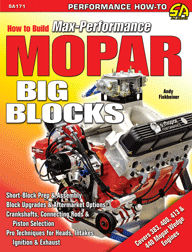How to Build Max-Performance Mopar Big Blocks Cartech Manual
$27.95 WASItem# CARTECH-SA171P
Weight: 1.5 lbs.
Publisher: CarTech Inc. / SA Design
Softcover: 144 pages
Dimensions: 8.5 x 11.0 x 0.4 inches
FREE SHIPPING ON ORDERS $200+
The photos in this edition are black and white.
Starting in the early 1960s, Mopar Wedge engines powered a wide range of Chrysler muscle cars, such as the Dodge Charger, Daytona Charger, Super Bee, Challenger, as well as Plymouth Barracuda, Superbird, Road Runner, GTX, and others. Many times these high-powered muscle cars were pursued by equally high-powered Dodge and Plymouth police cars that were also packing Mopar big-block power under the hood. In 1978, the last of the Mopar big-blocks rolled down the production line, but in an odd twist of fate, the popularity of the Mopar surged again in street and strip cars during the 1980s. By the 1990s, the big Mopar engine was more popular than ever.
Covers:
- Mopar's 383-, 400-, 413-, 426-, and 440-ci engines to power levels of 600 to 900 hp.
Contents:
- How to properly budget your engine build for a specific performance target
- How to select a stock or aftermarket block for the desired performance level
- The reciprocating assembly (crankshaft, connecting rods, and pistons) is examined in detail
- Cylinder heads and valvetrain configurations
- Stock modification options
- The best setups
- Selecting the right machine work
- The latest aftermarket head options for producing huge horsepower
- Building stroker engines
- Engine builds at 600, 700, 800, and 900 horsepower levels
Table of Contents:
Acknowledgments
About the Author
Preface
Introduction
Chapter 1: Planning the Engine Build
- Budgeting Process
- Power Goals
- Formulas for Engine Design
- Mopar-Specific Design Choices
Chapter 2: The Cylinder Block
- Cylinder Block Selection
- Thin Wall Controversy
- Basic Block Dimensions
- Fixes for the Factory Block
- Aftermarket Blocks
- Main Bearings
- Cylinder Bore Preparation
- Decking
- Block Detailing
- Valve Notches
Chapter 3: The Oil System
- Oil Pump
- Internal Oiling System
- External Oiling System
- Pump Cover
- The Intermediate Shaft
- Oil Pan
- Oil Type and Operation Temperature
- Oil Filter and Cooler
- Dry Sump System
- Top-End vs. Bottom-End Oiling
- Extra Lubrication Requirements
Chapter 4: Crankshafts
- Crankshaft Selection
- The Funny Car Crankshaft
- Crankshaft Preparation
- Balancing
- Harmonic Damper
Chapter 5: Connecting Rods
- Connecting Rod Selection
- Aluminum Rods
- Connecting Rod Preparation
- Rotating Assembly Balancing
Chapter 6: Pistons
- Compression Ratio Considerations
- Valve-to-Piston Clearance
- Combustion Chamber Clearance
- Piston-to-Head Clearance
- Piston Rings
- Gas Ports
- Piston Pin Diameter
- Vacuum Pump Considerations
Chapter 7: Cylinder Heads and Valves
- Standard Port Cylinder Head
- Max-Wedge-Port-Size Heads
- Bigger Than Max-Wedge
- Head Gaskets
- Head Flow and Cam Lift
- Valves
- Porting
Chapter 8: The Valvetrain
- Rocker Arm Geometry
- Rocker Arm Ratio
- Rocker Arm Material
- Rocker Arm Types
- Rocker Shafts and Supports
- Rocker Arm Width and Length
- Side Clearance and Alignment
- Multiple Shaft Systems
- Pushrods
Chapter 9: Camshafts and Lifters
- Duration
- Single Pattern vs. Dual Pattern
- Lifters
- Roller Lifters and Valvetrain Oiling
- Rev Kits
- Lifter Bore Bushings
- Camshaft Bearings
- Large-Diameter Cam Bearings
- Roller Cam Bearings
- Firing Order
Chapter 10: Camshaft Drives and Valvesprings
- Timing Chains
- Roller Cam Thrust
- Timing-Chain Covers
- Belt Drive
- Gear Drive
- Valvesprings
Chapter 11: Intake Manifolds
- Standard Port Intakes, B and RB
- Max-Wedge Port Intakes, B and RB
- B1 Intake Options
- EFI
Chapter 12: Carburetors
- Classic 4150 Double Pumper
- The 4500 Dominator
- Tuner-Friendly Carburetors
- Edelbrock and Carter Carburetors
- Carburetor Spacers
Chapter 13: Ignition Systems
- Electronic Ignitions
- Distributor
- Belt-Driven Distributor
- Crank Trigger
- Spark Plugs
- Indexing the Spark Plugs
- Spark Plug Wires
Chapter 14: Accessories
- Water Pumps, Electric and Belt-Driven
- Alternator Kits
- Engine Mounting Systems, Motor Plates and Elephant Ears
- High-Performance Hoses and Fittings
Chapter 15: Exhaust Systems
- Cast Manifolds
- Headers
- Picking a Header Size
- Relocated Exhaust Ports
- Merged Collectors and 4-2-1 Headers
- Stepped Tubes
Chapter 16: Tuning
- Reading the Plugs
- Wide Band
- Dynamometer Testing
- Chassis Dyno Testing
Chapter 17: The Fantastic 451 and Other Engine Combinations
- Fantastic 451/470
- Two Ways to 512
- Big Bad 572
Chapter 18: Recipes for Power
- 600 HP
- 700 HP
- 800 HP
- 900 HP
Engine Build Sheets
Source Guide


 Cart
Cart


